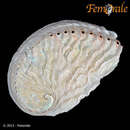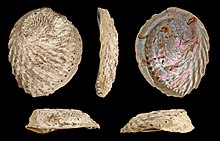fi
nimet breadcrumb-navigoinnissa


Haliotis midae, known commonly as the South African abalone or the perlemoen, is a species of large sea snail, a marine gastropod mollusk in the family Haliotidae, the abalones.[2]
It is highly sought after by criminal organisations and a thriving black market exists for it, leading to a catastrophic decline in stocks.[1]

The size of the shell varies between 12 and 20 cm (4.7–7.9 in). "The large shell has a rounded-oval shape and is moderately convex. The distance of the apex from the margin about equals one-fifth the greatest length of the shell. The body whorl is strongly angled at the position of the perforations, perpendicularly descending from the angle to the columellar margin. The surface shows strong, elevated, radiating wrinkles or lamellae, but no spiral markings when adult. The 6 to 11 perforations are small, subcircular, and separated by spaces greater than their own diameter. The two sides are about equally curved. The convexity varies with age. The colour of the shell is yellowish-gray. The folds are usually stained with coral-red. The surface is dull, with fine oblique growth-wrinkles and coarse, prominent, less oblique elevated and wavy radiating lamellae. The low spire is composed of about 3 whorls. The body whorl is angulated at the row of perforations. The inner surface is pearly, many-coloured, red predominating in young specimens. The muscle-scar is large, rounded, very rough, especially in old shells, which often have coppery stains inside. The columellar plate is rather broad (one-seventh to one-tenth the width of the shell), sloping inward. Its face is a little concave and not at all truncated at the base. The cavity of the spire is large, showing about 1½ whorls from below."[3]
H. midae live in groups.[4] Juveniles integrate with sea urchins for protection.[4]
H. midae are herbivores, feeding on kelp and red and green algae.
Haliotis midae is endemic to the waters off South Africa.[5]
H. midae is endangered due to severe overfishing from uncontrolled poaching driven by consumer demand in East Asia. Numerous East Asian poaching gangs have created an organised criminal enterprise in conjunction with local criminals and fishers, leading to a catastrophic decline in the species. These organisations are closely linked to the international narcotics trade. In most areas of former abundance, evidence indicates that populations have not been able to keep up with the level of poaching, leading to recruitment failure.[1]
The threat to the perlemoen led it to being banned from all types of harvesting and listed on CITES and the National Environmental Management: Biodiversity Act 10 of 2004 (NEMBA); it was later removed from both registers due to pressure from the fishing industry.[4]
Haliotis midae, known commonly as the South African abalone or the perlemoen, is a species of large sea snail, a marine gastropod mollusk in the family Haliotidae, the abalones.
It is highly sought after by criminal organisations and a thriving black market exists for it, leading to a catastrophic decline in stocks.
Haliotis midae is een slakkensoort uit de familie van de Haliotidae.[1] De wetenschappelijke naam van de soort is voor het eerst geldig gepubliceerd in 1758 door Linnaeus.
Bronnen, noten en/of referentiesHaliotis midae (em inglês Midas abalone,[2] South African abalone[3] ou perlemoen)[2] é uma espécie de molusco gastrópode marinho pertencente à família Haliotidae. Foi classificada por Linnaeus, em 1758. É endêmica do sul da África do Sul.[1][2][4]
É uma das cinco espécies do gênero Haliotis quase totalmente endêmicas da costa da África do Sul: Haliotis alfredensis, H. midae, H. parva, H. queketti e H. spadicea.[5]
Concha ovalado-circular de pouco mais de 15[2] até quase 25 centímetros, com grosseiras e espessas lamelas radiais, difusas, em sua superfície, dando-lhe um aspecto de drapeado.[6][7] A coloração vai de um creme claro, quase branco, passando pelo salmão[8] ao vermelho amarronzado. Os furos abertos em sua superfície, cerca de 9, são pequenos,[4] circulares e apenas ligeiramente elevados. Região interna da concha madreperolada, iridescente, com tons predominantes de verde escuro, cor-de-rosa e azul; apresentando o relevo da face externa visível. Ela pode estar recoberta por outros animais marinhos, quando em vida.[4][9]
Haliotis midae ocorre desde as águas rasas da zona entremarés até a zona nerítica, em áreas rochosas do litoral sul da África do Sul.[2][4] É o maior abalone deste país.[10]
Esta espécie é comercialmente pescada.[2] Fora da Ásia, a África do Sul é o maior exportador de abalone de criação, quase todo ele destinado ao mercado chinês; apelidado de "ouro branco" por causa de sua carne perolada. Isto coloca a população selvagem de Haliotis midae em perigo. Caçadores furtivos vasculham as rochas ao longo da costa da África do Sul para atender à demanda insaciável da Ásia. Este país é o terceiro maior fornecedor de abalones cultivados no mundo, perdendo apenas para a China e para a Coreia do Sul, de acordo com um relatório do Centro de Excelência em Gestão de Recursos Naturais (CENRM) da Universidade da Austrália Ocidental.[11] A crescente pressão de pesca sobre este abalone sul-africano levou, no início do século XXI, à proibição de sua colheita, sua colocação na CITES e sua listagem em uma lei de gestão ambiental; porém foram removidos os impedimentos de sua coleta por causa da pressão da indústria de pesca. Algumas avaliações feitas pelos pesquisadores mostram que as populações estudadas estão a diminuir.[3][12]
|coautor= (ajuda) |coautores= (ajuda) |coautor= (ajuda) Haliotis midae (em inglês Midas abalone, South African abalone ou perlemoen) é uma espécie de molusco gastrópode marinho pertencente à família Haliotidae. Foi classificada por Linnaeus, em 1758. É endêmica do sul da África do Sul.
É uma das cinco espécies do gênero Haliotis quase totalmente endêmicas da costa da África do Sul: Haliotis alfredensis, H. midae, H. parva, H. queketti e H. spadicea.
Haliotis midae, known commonly as the South African abalone or the perlemoen abalone, là một loài ốc biển, là động vật thân mềm chân bụng sống ở biển thuộc họ Haliotidae, the abalones.[1]
Haliotis midae is đặc hữu của the waters off Nam Phi.[2]
Phương tiện liên quan tới Haliotis midae tại Wikimedia Commons
Haliotis midae, known commonly as the South African abalone or the perlemoen abalone, là một loài ốc biển, là động vật thân mềm chân bụng sống ở biển thuộc họ Haliotidae, the abalones.